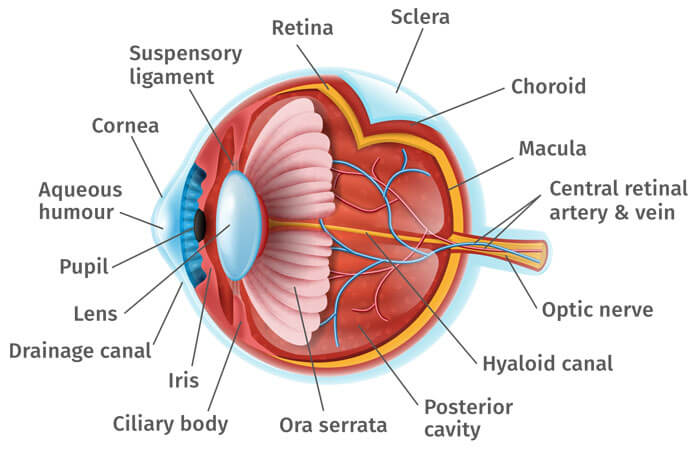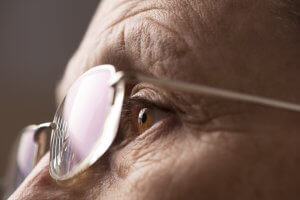Learn more about cataracts
What they are. Symptoms. Treatment options. And more!

Cataracts at a Glance:
- a clouding of the naturally clear lens inside the eye
- progressive & gradual
- very common
- the leading cause of visual loss in adults age 55 & older
- correctable with minimally invasive outpatient surgery
About Cataracts
What is a cataract?
A cataract is a clouding of the lens in the eye that affects vision. Most cataracts are related to aging. Cataracts are very common in older people. By age 80, more than half of all Americans either have a cataract or have had cataract surgery. A cataract can occur in either or both eyes. It cannot spread from one eye to the other.
Symptoms
What are the symptoms of a cataract?
The most common symptoms of a cataract are:
- Cloudy or blurry vision.
- Colors seem faded.
- Headlights, lamps, or sunlight may appear too bright. A halo may appear around lights.
- Poor night vision.
- Double vision or multiple images in one eye. (This symptom may clear as the cataract gets larger.)
- Frequent prescription changes in your eyeglasses or contact lenses.
- These symptoms also can be a sign of other eye problems. If you have any of these symptoms, check with your eye care professional.
Treatment Options
How is a cataract treated?
The symptoms of early cataract may be improved with new eyeglasses, brighter lighting, anti-glare sunglasses, or magnifying lenses. If these measures do not help, surgery is the only effective treatment. Surgery involves removing the cloudy lens and replacing it with an artificial lens.
A cataract needs to be removed only when vision loss interferes with your everyday activities, such as driving, reading, or watching TV. You and your eye care professional can make this decision together. Once you understand the benefits and risks of surgery, you can make an informed decision about whether cataract surgery is right for you. In most cases, delaying cataract surgery will not cause long-term damage to your eye or make the surgery more difficult. You do not have to rush into surgery.
Sometimes a cataract should be removed even if it does not cause problems with your vision. For example, a cataract should be removed if it prevents examination or treatment of another eye problem, such as age-related macular degeneration or diabetic retinopathy. If your eye care professional finds a cataract, you may not need cataract surgery for several years. In fact, you might never need cataract surgery. By having your vision tested regularly, you and your eye care professional can discuss if and when you might need treatment.
If you choose surgery, your eye care professional may refer you to a specialist to remove the cataract.
If you have cataracts in both eyes that require surgery, the surgery will be performed on each eye at separate times, usually four to eight weeks apart.
Many people who need cataract surgery also have other eye conditions, such as age-related macular degeneration or glaucoma. If you have other eye conditions in addition to cataract, talk with your doctor. Learn about the risks, benefits, alternatives, and expected results of cataract surgery.
Presbyopia
What is Presbyopia
Presbyopia is one of the first changes that results from the crystalline lens losing its flexibility. Presbyopia begins at around age 40 and progresses until about age 65. Until approximately the age of 40, the crystalline lens is both “crystal clear” and quite soft and flexible. This flexibility permits the crystalline lens to change its shape and alter its curvature so that it can help focus your vision at various distances-from far, to near, to arm’s length, to far or near again. This flexibility gives you the ability to see things at all distances.
Around the time we enter our 40’s, the crystalline lens begins to stiffen. The stiffening of the crystalline lens makes it progressively more difficult to change focus and thus to see clearly at all distances. Usually this reduces our ability to see objects clearly at arms-length or close objects or reading material. When this loss of flexibility occurs, it is called Presbyopia or “old eyes”. Presbyopia is a normal and expected consequence of growing older and it affects everyone. As the crystalline lens loses its ability to flex and change shape, it is no longer able to bend light rays. This results in a gradual and progressive loss of your ability to focus on near objects.
Patients who experience the start of Presbyopia will most often observe, that their “arms are too short” requiring them to see up close by moving near objects and reading material farther away in order to bring them into focus and see them clearly.
It is important to note that Presbyopia affects everyone including those who have cataracts. When Presbyopia begins people, who have never worn eyeglasses find that they need reading glasses or bifocals in order to read and see up close. People who already wear glasses may need bifocals or trifocals in order to see comfortably up close.
There have been many advances in cataract surgery and lens implant surgery techniques. Today, patients can elect to have presbyopia correcting multifocal lens implants so that lens replacement surgery can often help patients achieve clear distance vision as well restore their normal range of vision without being dependent on eyeglasses, bifocals or reading glasses.
Does my insurance plan
cover my eye care?
Find out what insurance we accept and what is covered by insurance.
Learn more about our cataract specialists
Physician information including education, training, practice location and more.
Schedule an Appointment
Schedule an appointment with one of our specialists.





